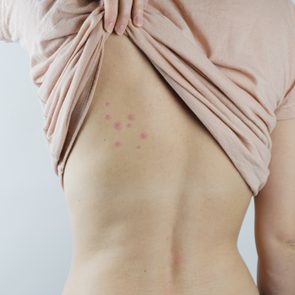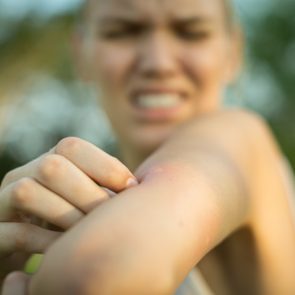Here’s How to Tell If You Have Chigger Bites or Scabies
Updated: Apr. 01, 2021
Was it a chigger or scabies bite? These mite bites both result in itching, but that's where the similarities end. Here's what you need to know—and how to protect yourself.
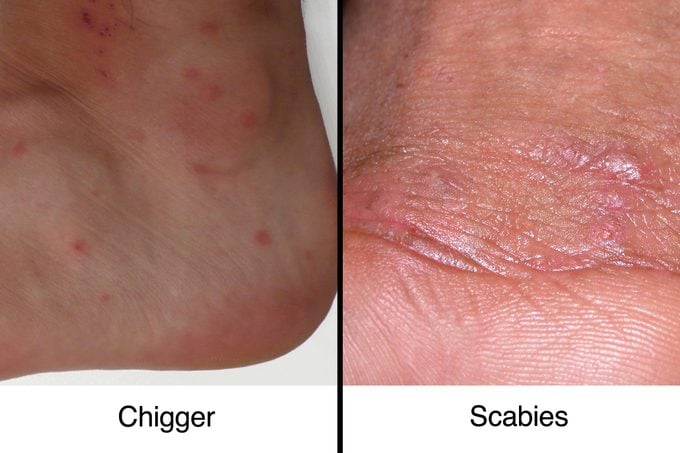 Chigger bites vs. scabies
Chigger bites vs. scabies
Chiggers and scabies are the mites that bite. Yep, both of these little biters are actually mites, which makes them arachnids, not insects. That means they are more closely related to ticks than other biting insects like mosquitoes.
But they each have their own style of biting, you get exposed to them in different ways, and only one of these mites is highly contagious and requires medical attention.
Here’s how to tell if your bites are due to chiggers or scabies—and how to protect yourself.
Where you’ll find chiggers
Chiggers are an outdoor biting pest. “They feed once, and will not reproduce indoors and have continuous generations,” says entomologist Jody Green, PhD, at the University of Nebraska, Lincoln.
They are typically found in wild plantings, gardens, pollinator habitat, woods and brush, long grass fields, trail edges, dense shrubbery, or even on short, manicured lawns. They like hot and humid conditions, and are most common in the South and Midwest in the United States. However, they can be found nearly anywhere in the world.
Chiggers are tiny, only about 1/100 of a millimeter in size and only bite people when they’re in the larva stage. (Here’s how you can tell the difference between a chigger bite and a mosquito bite.) While chiggers do stay attached to the body while they are feeding, they can be brushed (or scratched) off.
Where you’ll find scabies
An interesting (and possibly terrifying) fact about scabies mite is that they live inside the skin—on humans (and other mammals).
“Unlike chiggers, scabies is an infestation, meaning the scabies mite actually burrows under the top layer of one’s skin,” says dermatologist Adam Friedman, MD, professor and interim chair of dermatology at The George Washington University School of Medicine & Health Sciences.
Unfortunately, you can’t just flick them off your skin. They’re colorless and so tiny, a microscope is the only way to see them. (Here are the 12 gross things living on your body right now.)
Chigger and scabies bite symptoms
Undisturbed, chiggers might stay on the skin for three or four days before dropping off. Scabies, on the other hand, aren’t going anywhere. They can cause a persistent, maddening itch for months or even years until you get a treatment that kills them. (There’s a reason they sometimes call scabies the seven-year itch.)
“Chiggers are ectoparasites, so they bite and feed on the outside of the body. Scabies mites burrow under the surface of the skin,” says Green.
Both bites result in intense itching, but that’s where the similarities end.
Chigger bites
Chiggers will typically deliver a higher number of smaller sized bites, and they tend to target the lower legs, explains Dr. Friedman. Bites often appear as small, reddish, bumps that look like pimples, with severe itching that is often worse at night.
Green was bitten by chiggers, and she describes it as “the most annoying and most intensely insane itching I’ve experienced.” (Bed bugs also like a good blood meal: Here’s are the key differences of a chigger bite vs. a bed bug bite.)
Chigger bites turn up near the ankles and behind the knees, along with any spot where your clothing fits tighter (a waistband, bra line, or the top of socks). “They will migrate to areas of “protection,” and in this case, you can see multiple little “bites” in a line along the waist, for example,” says Dr. Friedman.
And they’ve been known to bite in moist places like the groin and armpit area too. (Stock up on these chemical-free insect repellents to keep bugs at bay.)
Scabies bites
“Scabies are rarely localized to a single area of the body,” Green says. They tend to gravitate to folded areas of the skin to burrow, including between the fingers, the elbow and wrist area, the waist, around genitals, and the buttocks, etc.
Yet, they can affect the entire body from head to toe, Dr. Friedman says. It’s not just exposed skin either. “Skin covered by clothing, jewelry, watchband or ring are other common places to find scabies on the body,” says Dr. Friedman.
As they burrow, they ingest tissue and feed on lymph fluids secreted by the skin, and that results in a itchy rash that looks like red bumps, pimples, or hives. Intense itching can leave sores and bruises. Like chiggers, the itching can be worse at night.
“In adults, the mites rarely burrow into the skin above the neck,” Dr. Friedman says.
Children often have scabies worse than adults. “Scabies can affect the entire body, including the palms, soles, and scalp. Infants and children who have scabies may be tired and irritable from lack of sleep, since scratching at night can keep them awake, and unlike adults, children often get blisters or large nodules from scabies infection,” adds Dr. Friedman. (Keep these tips in mind when you’re looking for a good pediatrician.)
In relatively rare cases, scabies infestations can be so severe that thick crusts of skin develop that have a “super infestation” of scabies and their eggs. This is known as crusted scabies or Norwegian scabies and can occur in people who are elderly, disabled, or those who have weakened immune systems.
In those cases, the itching and rash normally associated with scabies may be absent. A person with ordinary scabies might have 10 to 15 mites on their body, while someone with crusted scabies will have thousands of them.
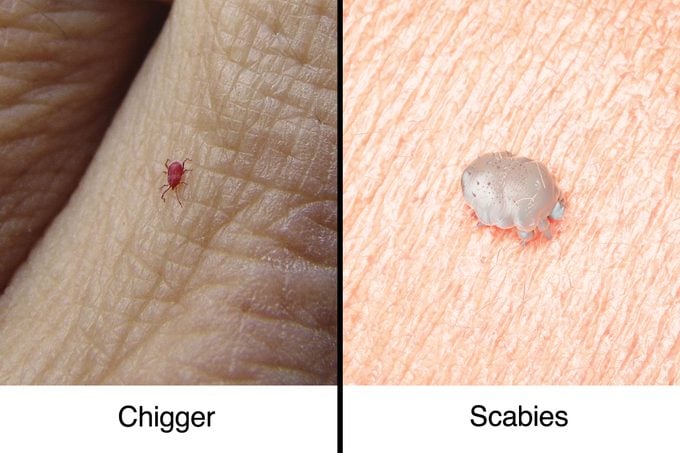 How long does it take to see a reaction?
How long does it take to see a reaction?
Chigger bite reaction
Chigger bites can occur at any time, whether you’re outside during the day or at night. You may react to getting bit, and ask yourself, “What just bit me?” But you may not see the reddish bite marks that look like pimples or feel the miserable itching right away, says Dr. Friedman: Reactions tend to occur in about six to 12 hours but can take longer. (Keep an eye out for these dangerous bugs this summer.)
Scabies bite reaction
Like with all insect and mite bites, the reaction time will vary depending on the person’s immune response. It’s not the burrowing itself that causes a reaction, but the mite, it’s eggs and fecal matter. Still, Dr. Friedman says, “It may take two to six weeks for the signs and symptoms of scabies to appear in people who have never had the condition.
The itching can start much sooner if you’ve had scabies before. “If a person has had scabies in the past, they usually start itching within one to four days of contact,” Dr. Friedman says. (Here’s how to tame itchy skin with these home remedies.)
Treatment for mite bites
Chigger bites
You might not want to know the mechanics behind a chigger bite, but it helps to understand why you’re itching so bad and why it lasts so long. “Chiggers pierce the skin with a small mouthpart and secrete enzymes into your skin, breaking it down. At the same time, they create a channel or tube (called a stylostome) to suck up the liquified skin cells,” says Green.
The damage from the skin breaking and the duration of how long they ate, equates to how long you will itch. You’re basically going to feel itchy until new skin starts to grows over the little sucking tubes the chigger made. For Green, it took about one week of “uncontrollable itching.”
For others, it can take two weeks to a month. Unlike the itching from scabies, a chigger bite itch will eventually go away. (Unless you get bit by more chiggers.) The scabies itch continues until you see a doctor for a treatment that will kill them.
To get relief from chiggers-related itching, Dr. Friedman has a few suggestions. “Oral antihistamines or topical corticosteroid creams/ointment. Cold compresses (ice, frozen peas) may also help to obscure the sensation and limit swelling.” (Here’s how to make your own DIY doctor-approved ice packs with things you already have in your house.)
Chigger bites are annoyingly itchy. If you can’t stop itching, call your doctor or dermatologist to get a prescription for a higher potency topical steroid. It’s essential to keep the scratching at a minimum. Otherwise, it can lead to a secondary skin infection.
Dr. Friedman says to call your doctor if you have pain, swelling, pus (white or greenish discharge), fever, weakness, or joint pain. You might not even have to go to the doctor’s office for a diagnosis. (Find out how to make a telehealth appointment work for you.)
Scabies bites
You won’t get by with anti-itch cream to treat scabies because scabies is very contagious. “Most scabies treatments are topical medications, which are applied to the skin. Permethrin five percent cream is the most common medicine used to treat scabies. It’s applied head to toe the first dose and then again in seven days.
Oral ivermectin (while not FDA approved specifically for scabies treatment) deserves consideration as it has shown to be a more practical and effective treatment.
Dosage is based on body weight and repeated a week after the first dose. Other topicals include crotamiton and sulfur ointment for treating scabies in young children and pregnant women. Prescription medicine can kill scabies but the itch may persist for weeks after that.
“The itchy rash can persist for two to three weeks as the dead mites and eggs can continue to annoy the immune system, as the top layer of the skin turns over every 14 days,” adds Dr. Friedman. Topical steroids should help the itch and inflammation. (Here are the 13 OTC skin care products dermatologists love.)
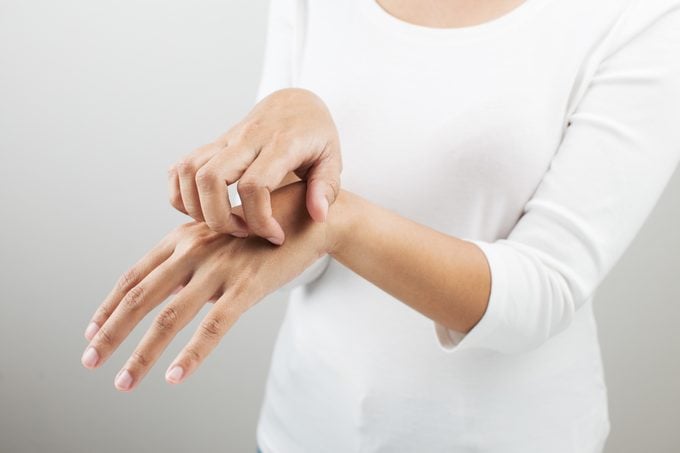 How to prevent mite bites
How to prevent mite bites
Chiggers
Even with the known habitat we mentioned earlier, chiggers can basically be anywhere when you are outside, Green says. That’s why you shouldn’t walk barefoot or sit directly on the grass.
The best way to prevent chigger bites is covering up. That might not be too appealing in hot summer temperatures, but it’s essential, especially if you know you’ll be in known chigger territory.
“Wear long pants, long sleeves, shoes, boots to cover up and keep chiggers on the outside. Tuck your pants into your shoes or boots and tuck your shirt into your pants,” advises Green. She also recommends wearing permethrin-treated clothing and also DEET (25-30 percent) on the skin.
Because chiggers can hitchhike on clothing, prevent more bites by immediately taking a shower and scrubbing the skin once you get inside. Be sure to wash and dry soiled clothes on high heat to kill chiggers. Wipe down shoes and boots.
You can also cut mitigate the chances of getting chigger bites by keeping turf short and vegetation trimmed. Green says residual insecticides (synthetic pyrethroids) with the active ingredient, bifenthrin, can help suppress chiggers, but spraying large areas can kill beneficial insects and pollinators. (Don’t overlook these surprising hazard zones in your backyard.)
Scabies
Scabies are contagious. They are primarily transmitted by direct human to human contact. But they can be transmitted without touching another human if scabies are on blankets, towels, sheets, and other personal items.
“Scabies mites can survive off the host for up 36 hours and longer in some environmental conditions, so if we’ve been exposed, they will get on our skin and burrow into the epidermis, the upper layer of skin,” says Green. Avoid prolonged close contact with people who have scabies, and if you live someone who has a confirmed case of scabies, Dr. Friedman recommends being treated for scabies. Scabies can also be spread to sexual partners due to skin-to-skin contact.
In addition to the medicinal treatment, some housecleaning is highly recommended to ensure eradication. “Wash all bedding, clothes, and towels that have touched your skin during the past six weeks. Use the hottest water possible for washing and drying,” advises Dr. Friedman.
Anything that can’t be washed in a washing machine should be dry cleaned or sealed in a plastic bag for at least a week. Finally, vacuum your entire home. After vacuuming, throw away the vacuum bag. Vacuum cleaner’s with canisters should be washed with hot, soapy water or cleaned with a cleaning wipe. (Here’s how a messy house could be making you sick.)























